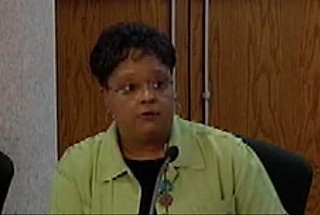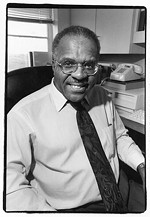Travis County 'Death Spiral'
A Commissioners Court seminar in how not to manage human resources
By Amy Smith, Fri., Oct. 2, 2009
But reams of documents since provided by the county through open records requests reflect a much more complicated workplace situation within the Human Resources Management Department – a situation that commissioners and the county attorney had long been aware of before they finally decided to take action. By waiting from roughly 2002 until late 2008 to try to resolve the problem – first with a "climate assessment report" of the HR department and later a mediator – it appears commissioners enabled or tolerated a nasty state of affairs that eventually became what one county employee called a "death spiral." Ultimately, commissioners came to believe their only solution was to fire both the supervisor, Executive Manager Alicia Perez, and her subordinate, Human Resources Director Linda Moore Smith.
By the time the county voted to terminate the two managers, the tangible price tag for the failed remediation had hit nearly $68,000, with more than $40,000 of that amount spent investigating employee complaints against Smith. And the bills will keep on coming. The final tab is expected to be well into the six figures, given the commissioners' stated intent to negotiate severance agreements with Perez and Smith.
Setting aside the irony of a dysfunctional human resources department – traditionally expected to be the steady personnel anchor of an organization – the commissioners' action raises questions about why the longstanding HR dilemma reached the point of a very public ouster of two minority women approaching retirement age (Perez, 57, is Hispanic, and Smith, now 60, is African-American).
County commissioners have laid the blame squarely on Perez's shoulders. They say she failed to manage Smith, who, despite her professional abilities to deliver on her job responsibilities, was a source of friction within the department. According to internal memos and the climate assessment report conducted by Employment Practices Solutions Inc., Smith had a history of abusiveness and disrespectful treatment of employees. The December 2008 report cites "a climate of verbal abuse, intimidation and suppression affecting employees in HRMD; where Ms. Smith [and one of Smith's managers] have been free to yell at employees, slam doors and otherwise act without civil, common and ordinary restraint."
The report also refers to strained relations between Perez and Smith, which ultimately became the commissioners' ammunition for terminating both.
In her nearly 12 years as HR director, Smith had four Equal Employment Opportunity Commission complaints filed against her, and had gone through five employee relations managers in nine years. Two of the former managers, both African-American males, were among the four employees who filed EEOC complaints. Smith's attorney, Terry Davis, points out that the complaints were found to be without merit; however, the county spent hours in multiple executive sessions negotiating settlements with two of the employees, while a third complaint has moved to litigation. Davis also said Smith is declining media interviews, explaining, "My client has never been one to seek publicity."
Stormy Weather
The commissioners' HR shakedown may continue to have legal reverberations and could have an impact on the re-election campaigns of County Judge Sam Biscoe and 4th Precinct Commissioner Margaret Gómez, each expected to seek another term in 2010. Gómez seconded Biscoe's July 28 motion to place Perez and Smith on administrative leave. But on Sept. 1, when commissioners took final action, Gómez joined Commissioner Ron Davis in voting against terminating Perez and Smith. Her vote change came after sharp criticism from Hispanic leaders – and the threat of drawing a viable political opponent in 2010 (former Austin City Council Member Raul Alvarez is a possible candidate). In any event, by the time of the Sept. 1 vote, the damage had already been done. Perez and Smith had been effectively fired July 28; the vote to place the women on administrative leave also included specific instructions to clean out their offices. "It was a painful experience, to say the least," Perez said of the commissioners' actions. "To come out [of executive session] and say, 'You're fired' ... that was bloody wicked."
Gómez now says she was not aware of how bad things were in the HR department until the problems had escalated into a crisis-management situation. "On top of that," she said, "I tried hard not to meddle with any of the executive managers and their employees." Gómez echoed the implication of the outside consultant's climate assessment report, citing a poor working relationship between Perez and Smith. As the assessment states, "Several [employees] reported a 'trickle down' effect, suggesting Ms. Perez's attitude toward Ms. Smith causes Ms. Smith to either 'go off' on HRMD employees or withdraw." Gómez firmly believes the unrest in human resources originated from a conflict between Perez and Smith. "To give them credit, they both did deliver the county work, [but] they had this conflict; they didn't like each other, they didn't trust each other ... and then the employees started filing complaints."
But Perez and several former and current employees take issue with such a simplistic explanation. "Our conflict started when those complaints started. I could not ignore them," said Perez, who hired Smith for the HR position in 1997. But, Perez added: "We weren't at each other's throats. It wasn't as horrible as people make it seem."
County documents dating back to 2004 and 2005 include e-mails from employees to Biscoe, commissioners, and the County Attorney's Office, and they raise concerns about Smith's management style. The records also do not support the tidy "trickle down" theory that the complaints against Smith were a direct result of Perez's treatment of her.
By 2008, however, records show that the relationship between the executive manager and the HR director had indeed reached a tipping point. Perez's memos to Smith between late 2007 and 2008 carry the tone of a supervisor who has completely run out of patience. "I am very disappointed in our conversation on Friday," Perez wrote in a two-sentence e-mail to Smith Oct. 22, 2007. "Perhaps we can engage the County Attorney to help mediate our differences." Another e-mail, this one dated Nov. 1, 2007, concerns Perez's dismay over Smith's secrecy regarding an executive search process – and it closes with a statement that certainly sounds like a warning of a potential dismissal. "I spoke with the Judge [Biscoe] and he supports the perspective that recruitment for any position should be transparent and not a 'closed' process. ... Since our perspectives are so opposed on how important the principle of open and honest communication is to Travis County and what our roles are to make sure we maintain public integrity and organizational values, it may be time for us to consider alternatives to our working relationship."
Yet if the problems in HR did indeed originate with Smith, Gómez asks, "I have to be left with the thought, 'Why didn't [Perez] take action?'"
Pointing Fingers
The answer is buried somewhere within two conflicting accounts. In 2005, the Travis County Attorney's Office investigated two complaints against Smith and found she had not violated any laws or policies. The investigation did, however, cite problems with Smith's interactions with employees. Perez says she sought the green light from the County Attorney's Office to give Smith the opportunity to resign. But there was a sense among county officials that Smith would not voluntarily resign, Perez said, and the logical solution in 2005 – in terms of avoiding litigation – was to place Smith on a performance improvement plan, instructing Smith to receive coaching on "interpersonal relationships and work environment communications."
On two previous occasions, Perez said, the legal staff had blessed her decision to seek resignations of other department heads, both white males. County commissioners' remarks in their job evaluations of Perez indicate they were happy with Perez's new replacement hires in those departments, but they continued to find fault with HR, the most time-consuming burden of Perez's multifaceted responsibilities. "I believe we need to talk about a change in direction at the top in HRMD," former Commissioner Karen Sonleitner wrote in her 2002 evaluation. "I think that Linda [Moore Smith] has taken this department as far as it can, and I'm ready for someone to take it to the next level." And again, in 2004, Sonleitner wrote, "I'm still unhappy with Linda's direction at HRMD."
Perez followed through with the county attorney's advice to place the HR director on a performance improvement plan. The June 2005 directive called for Smith to draw up a plan of action to address her interpersonal skills with HR employees and other county staff. In the same document, Perez commended Smith on her "ability to accomplish tasks and articulate Human Resources principles." Smith responded a few weeks later with the requested action plan, while strongly suggesting that the problems were not entirely her responsibility. "I am committed to address any actual or perceived communication gaps," Smith wrote (emphases in original). "Conversely, I am cognizant that any efforts on my part to enhance communications and workplace relationships require the commitment and effort of others whose attitudes, behaviors and practices are not within my authority to change."
Biscoe, for his part, says when Perez discussed the possibility of terminating Smith, he advised her to talk to the legal department, but he flatly denies accusations that he actively blocked Perez's efforts to fire Smith. "This thing about me not wanting her to fire [Smith] is hogwash," Biscoe said. "Alicia," he said, "is blaming everybody else. ... Alicia doesn't admit to anything."
Under the performance plan, Perez said Smith started to show improvement, "but then the complaints started again."
Brought to a Boil
County documents show Perez's next attempt to oust Smith came in July 2008. The legal department instructed Perez to present documentation to support her rationale for dismissing Smith. In her August 2008 memo to Biscoe and County Attorney David Escamilla, Perez cited a number of reasons, including "discord and instability" in HR's Staffing, Training and Employee Relations Division, which had seen the turnover of five managers in nine years. Additionally, Perez wrote, "Difficulties in communication between Ms. Smith, her colleagues, her supervisor, her staff, and elected and appointed officials have diminished her effectiveness as HRMD director." Perez acknowledged that her own communications with Smith "have also been strained and grow increasingly difficult."
By the time Perez submitted the 2008 letter seeking Smith's termination, commissioners had begun discussing hiring an outside consultant to conduct a climate assessment of the HR department, Biscoe said. The strained relations between Perez and Smith quickly became the focal point of the consultant's assessment. A mediator was brought in. In the end, the long-simmering management problems in HR – the source of complaints and high turnover throughout the years – boiled down to a very rudimentary public explanation: The two women just could not get along. The explanation was apparently satisfactory to the county judge and most of the commissioners. "They would work together for a couple of months, and then there would be a flare-up," Biscoe said, as though the entire problem was little more than a personal conflict between the two women.
Former commissioner Sonleitner says she was disappointed with the public portrayal of the two female managers. "The way this was presented fed every horrible and false stereotype out there that some folks want to believe – that women can't manage, that minorities can't be good managers, and that government in general can't manage."
Nor did the "cat fight" explanation – as some observers began to dismissively describe the situation – wash with Perez's supporters. Nearly 30 of them, including at least eight county employees, appeared before commissioners Aug. 4 to voice their concerns about the county's handling of the matter. At least a couple of speakers noted that neither Perez nor Smith deserved to be treated so poorly in such a public manner.
Biscoe later acknowledged his surprise to see the number of rank-and-file employees – ranging from a deputy constable to a groundskeeper – who testified on behalf of Perez, calling the testimony "not a good move in my view." One of the speakers was in fact his longtime aide, Sheryl Brown, who helped Perez pack up her office the night of July 28. She told commissioners, "I was in shock" over their dismissal of Perez.
"I was raised by wise parents ... and they said if you don't stand up for something, you will fall for anything. I'm saying this now," Brown said over scattered applause, "I came here as an employee of Travis County because I stand up for what I saw ... the integrity [of Perez] and how she treated employees."
Got something to say on the subject? Send a letter to the editor.











